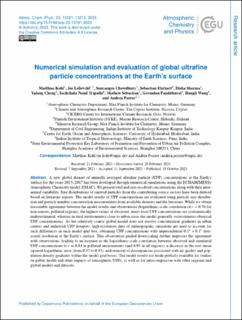| dc.contributor.author | Kohl, Matthias | |
| dc.contributor.author | Lelieveld, Jos | |
| dc.contributor.author | Chowdhury, Sourangsu | |
| dc.contributor.author | Ehrhart, Sebastian | |
| dc.contributor.author | Sharma, Disha | |
| dc.contributor.author | Cheng, Yafang | |
| dc.contributor.author | Tripathi, Sachchida Nand | |
| dc.contributor.author | Sebastian, Mathew | |
| dc.contributor.author | Pandithurai, Govindan | |
| dc.contributor.author | Wang, Hongli | |
| dc.contributor.author | Pozzer, Andrea | |
| dc.date.accessioned | 2024-03-18T13:38:37Z | |
| dc.date.available | 2024-03-18T13:38:37Z | |
| dc.date.created | 2023-12-20T13:18:47Z | |
| dc.date.issued | 2023 | |
| dc.identifier.citation | Atmospheric Chemistry and Physics (ACP). 2023, 23 (20), 13191-13215. | en_US |
| dc.identifier.issn | 1680-7316 | |
| dc.identifier.uri | https://hdl.handle.net/11250/3122924 | |
| dc.description.abstract | A new global dataset of annually averaged ultrafine particle (UFP) concentrations at the Earth's surface for the years 2015–2017 has been developed through numerical simulations using the ECHAM/MESSy Atmospheric Chemistry model (EMAC). We present total and size-resolved concentrations along with their interannual variability. Size distributions of emitted particles from the contributing source sectors have been derived based on literature reports. The model results of UFP concentrations are evaluated using particle size distribution and particle number concentration measurements from available datasets and the literature. While we obtain reasonable agreement between the model results and observations (logarithmic-scale correlation of r=0.76 for non-remote, polluted regions), the highest values of observed, street-level UFP concentrations are systematically underestimated, whereas in rural environments close to urban areas the model generally overestimates observed UFP concentrations. As the relatively coarse global model does not resolve concentration gradients in urban centres and industrial UFP hotspots, high-resolution data of anthropogenic emissions are used to account for such differences in each model grid box, obtaining UFP concentrations with unprecedented horizontal resolution at the Earth's surface. This observation-guided downscaling further improves the agreement with observations, leading to an increase in the logarithmic-scale correlation between observed and simulated UFP concentrations to r=0.84 in polluted environments (and 0.95 in all regions), a decrease in the root mean squared logarithmic error (from 0.57 to 0.43), and removal of discrepancies associated with air quality and population density gradients within the model grid boxes. The model results are made publicly available for studies on public health and other impacts of atmospheric UFPs, as well as for intercomparison with other regional and global models and datasets. | en_US |
| dc.language.iso | eng | en_US |
| dc.publisher | Copernicus Publications | en_US |
| dc.rights | Navngivelse 4.0 Internasjonal | * |
| dc.rights.uri | http://creativecommons.org/licenses/by/4.0/deed.no | * |
| dc.title | Numerical simulation and evaluation of global ultrafine particle concentrations at the Earth's surface | en_US |
| dc.title.alternative | Numerical simulation and evaluation of global ultrafine particle concentrations at the Earth's surface | en_US |
| dc.type | Peer reviewed | en_US |
| dc.type | Journal article | en_US |
| dc.description.version | publishedVersion | en_US |
| dc.source.pagenumber | 13191-13215 | en_US |
| dc.source.volume | 23 | en_US |
| dc.source.journal | Atmospheric Chemistry and Physics (ACP) | en_US |
| dc.source.issue | 20 | en_US |
| dc.identifier.doi | 10.5194/acp-23-13191-2023 | |
| dc.identifier.cristin | 2216382 | |
| cristin.ispublished | true | |
| cristin.fulltext | original | |
| cristin.qualitycode | 2 | |

